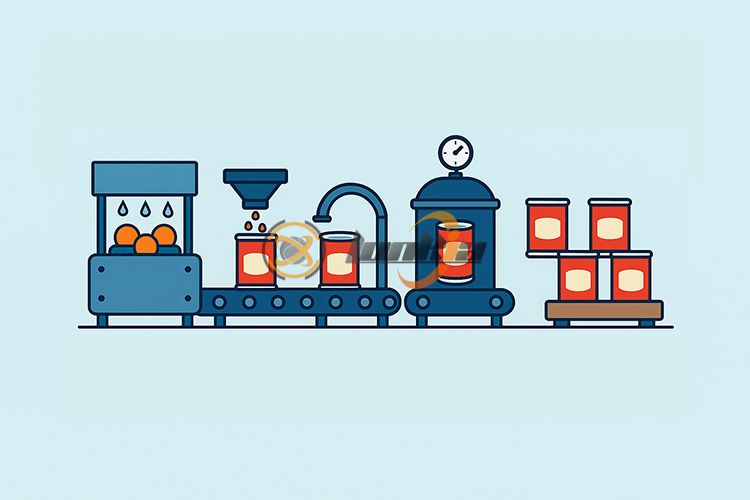In today’s fast-paced food industry, efficiency, hygiene, and shelf life are critical. One of the most effective ways to preserve food products—whether fruits, vegetables, meats, or ready-to-eat meals—is through canning. But how do manufacturers achieve this on a massive scale? The answer lies in a canning production line.
In this article, we’ll explore what a canning production line is, the key components involved, and how the entire process works to safely preserve food while maintaining quality and flavor.
What Is a Canning Production Line?
A canning production line is a fully integrated system of machines designed to automate the process of sealing food in cans or jars for long-term storage. These production lines are commonly used in the food and beverage industry to process items such as canned vegetables, fruits, seafood, meats, soups, and even pet food.
Canning production lines come in manual, semi-automatic, and fully automatic configurations depending on production volume and operational needs. Whether used by a small food processor or a large industrial factory, these systems streamline operations, reduce human error, and improve product consistency.

Key Components of a Canning Production Line
A typical canning production line includes the following core machines and subsystems:
1. Washing and Sorting Unit
This unit cleans raw materials (like fruits or vegetables) and sorts them based on size and quality. Cleanliness is crucial for food safety and regulatory compliance.
2. Cutting or Peeling Machines (if applicable)
For items such as peaches, mangoes, or potatoes, peeling and slicing machines are used to prepare the raw material for canning.
3. Blanching or Cooking Machine
Blanching helps inactivate enzymes, reduce microbial load, and improve texture and color before canning. For meat or seafood, this may involve partial or full cooking.
4. Filling Machine
This machine fills cans or jars with the processed food, ensuring precise volume and reduced spillage. Liquids such as syrup, oil, or brine may be added during this stage.
5. Vacuum Sealing or Lid Seaming Machine
The container is sealed using vacuum and steam methods to eliminate oxygen, which helps prevent spoilage and bacterial growth.
6. Sterilization or Retort System
This is one of the most important stages. The sealed cans are sterilized under high temperature and pressure to ensure shelf stability. This step effectively destroys harmful bacteria.
7. Cooling Conveyor
After sterilization, cans must be cooled down quickly to avoid overcooking and to maintain product integrity. This is typically done using chilled water.
8. Labeling and Coding Machine
Once cooled and dried, the cans are labeled and batch coded for tracking, compliance, and retail use.
9. Packaging System
Finally, the finished products are grouped and packed into boxes or shrink-wrap for storage or shipment.
How Does a Canning Production Line Work?
The process is typically continuous and highly synchronized:
Preparation: Raw ingredients are washed, sorted, and sometimes peeled or sliced.
Pre-cooking/Blanching: Items are partially cooked or blanched to prepare them for preservation.
Filling: Clean, sterile cans or jars are filled with solid ingredients and, if needed, liquid fillers.
Sealing: Containers are sealed in a vacuum to remove air and ensure airtight closure.
Sterilization: The sealed containers are placed in retorts (pressure cookers) to be sterilized.
Cooling & Drying: After sterilization, cans are cooled and then dried to prevent rusting.
Labeling & Packing: Products are labeled, batch-coded, and packed for transport.
This automated cycle ensures high output, consistent quality, and food safety compliance with standards such as HACCP, FDA, or ISO certifications.
Advantages of Using a Canning Production Line
✅ Extended Shelf Life: Foods can last for months or years without refrigeration.
✅ Labor Efficiency: Automation reduces the need for manual labor and human error.
✅ Food Safety Compliance: Proper sterilization ensures products are microbiologically safe.
✅ Scalability: Easily adjustable for different product types and batch sizes.
✅ Cost Efficiency: Long-term reduction in operational and labor costs.
Final Thoughts
A canning production line is the backbone of modern food preservation. Whether you're a small-scale producer expanding your output or a large food manufacturer optimizing your workflow, investing in a quality canning line offers long-term advantages in product safety, consistency, and operational efficiency.
At LONKIA Machinery, we specialize in customized canning production line solutions for a wide range of food applications. Contact us today to discuss your specific requirements and take your production to the next level.
